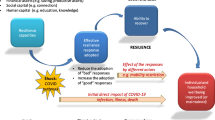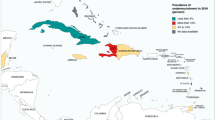Abstract
Russia’s foreign trade relations in the 2010s developed in the face of various geopolitical challenges, which led to a radical transformation in the volume and geography of export–import operations. For the food sector, the key challenge was the food embargo of 2014, which, in turn, intensified import substitution policy in Russian agriculture and food production. The value of imports in the food market, the current level of development of agriculture and food production, the degree of diversification and localization of raw material relationships of enterprises acted as differentiating factors in the impact of new external challenges on the food self-sufficiency of regions. Kaliningrad oblast is of particular interest for studying the transformation of food self-sufficiency, given its exclave position, a low level of agricultural development a decade ago, and close export–import ties with European countries until 2014. The paper assesses food self-sufficiency, analyzes the corresponding territorial and sectoral shifts in agriculture and food production, and considers changes in the import component in the food market of Kaliningrad oblast. The study uses data from the Federal State Statistics Service, the Kaliningrad Oblast Customs Service, and the results of expert interviews and visual observations conducted by the authors in August 2020. It was revealed that transformation of the food self-sufficiency of Kaliningrad oblast, on the one hand, reflects all-Russian trends, and on the other, has unique features. The uniqueness is associated with the rapid growth of agriculture as a result of government support. In addition, there is a relatively dispersed distribution of key centers of agricultural production, atypical of many regions in mainland Russia. The beneficiaries of the free market niches that opened up after the 2014 food embargo, as in most of Russia, were large holdings, but many of them, in contrast to those located in the country’s interior, were quite acutely aware of breaks in raw material ties.






Similar content being viewed by others
Notes
On Approval of the Doctrine of Food Security of the Russian Federation: Decree of the President of the Russian Federation no. 120 of January 30, 2010. Accessed from the legal reference system ConsultantPlus.
On approval of the Food Security Doctrine of the Russian Federation: Decree of the President of the Russian Federation no. 20 of January 21, 2020. Accessed from the legal reference system ConsultantPlus.
Food balance sheets, 2007–2017 Rosstat. https://rosstat.gov.ru/folder/11110/document/13277. Accessed Sep-tember 26, 2021; Food balance sheets, 2018, 2019. Rosstat. https://rosstat.gov.ru/compendium/document/13278. Accessed September 26, 2021.
There is no personal consumption for grain and legumes; use of grain and its processing products for processing into products are estimated.
Order of the Federal State Statistics Service (Rosstat) of the Ministry of Economic Development of Russia no. 389 of July 16, 2020 On Approval of the Methodology for Compiling the Balance of Fish and Fish Products to Determine the Average Per Capita Level of Their Consumption. https://rosstat.gov.ru/storage/mediabank/hZfgYRzC/met-balans.pdf. Ac-cessed March 5, 2022.
“Fishery Complex of Kaliningrad Oblast” (under of the State Program of Kaliningrad Oblast “Development of the Fishery Complex for 2014−2019, stage 1”): analytical note. Kaliningrad: Kaliningradstat, 2020.
Order of the Ministry of Health of the Russian Federation no. 614 of August 19, 2016 On Approval of the Recommendations on Rational Norms for the Consumption of Food Products that Meet Modern Requirements for a Healthy Diet. Accessed from the legal reference system ConsultantPlus.
EMISS: Average consumer prices (tariffs) for goods and services. https://www.fedstat.ru/indicator/31448. Accessed September 29, 2021.
Rosstat: Income, expenditure, and consumption of households. https://rosstat.gov.ru/folder/11110/document/13271. Accessed September 9, 2021.
Hereinafter the municipal status of areas is specified as of 2022.
REFERENCES
Born, B. and Purcell, M., Avoiding the local trap: scale and food systems in planning research, J. Plann. Educ. Res., 2006, vol. 26, no. 2, pp. 195–207. https://doi.org/10.1177/0739456X06291389
Donald, B., Gertler, M., Gray, M., and Lobao, L., Re-regionalizing the food system? Cambridge J. Reg., Econ. Soc., 2010, vol. 3, no. 2, pp. 171–175. https://doi.org/10.1093/cjres/rsq020
Fedorov, G.M., Voloshenko, K.Yu., Gorochnaya, V.V., Gumenyuk, I.S., Druzhinin, A.G., Zverev, Yu.M., Kuznetsova, T.Yu., Lachininskii, S.S., Lyalina, A.V., and Mikhailova, A.A., Problemy ekonomicheskoi bezopasnosti regionov zapadnogo porubezh’ya Rossii (Problems of Economic Security of the Regions of the Western Borderlands of Russia), Kaliningrad: Balt. Fed. Univ im. I. Kanta, 2019.
Fedorov, M.V. and Kurdyumov, A.V., Mekhanizm obespecheniya prodovol’stvennoi bezopasnosti Rossiiskoi Federatsii (Mechanism for Ensuring Food Security of the Russian Federation), Yekaterinburg: Ural. Gos. Ekon. Univ., 2013.
Filippov, R.V., Economic and geographical features of the formation of food security in the region, Cand. Sci. (Geogr.) Dissertation, Irkutsk: Sochava Inst. Geogr. Sib. Branch Russ. Acad. Sci., 2017.
Graef, F., Sieber, S., Mutabazi, K., et al., Framework for participatory food security research in rural food value chains, Global Food Secur., 2014, vol. 3, no. 1, pp. 8–15. https://doi.org/10.1016/j.gfs.2014.01.001
Hinrichs, C., Regionalizing food security? Imperatives, intersections and contestations in a post-9/11 world, J. Rural Stud., 2013, vol. 29, pp. 7–18. https://doi.org/10.1016/j.jrurstud.2012.09.003
Kneafsey, M., The region in food—important or irrelevant? Cambridge J. Reg., Econ. Soc., 2010, vol. 3, no. 2, pp. 177–190. https://doi.org/10.1093/cjres/rsq012
Kornekova, S.Yu., On the regional level of food security in Russia, Izv. S.-Peterb. Gos. Ekon. Univ., 2015, vol. 96, no. 6, pp. 17–22.
Leroy, J.L., Ruel, M., Frongillo, E., Harris, J., and Ballard, T.J., Measuring the access dimension of food security: A critical review and mapping of indicators, Food Nutr. Bull., 2015, vol. 36, no. 2, pp. 167–195. https://doi.org/10.1177/0379572115587274
Morachevskaya, K.A., Zinov’ev, A.S., Krasnov, A.I., and Krasnova, M.V., Dynamics of the territorial structure of the dairy industry in the Russian–Belarusian border area in the 2010s, Vestn. Mosk. Univ., Ser. 5: Geogr., 2020, no. 3, pp. 63–72.
Nikiforova, I.V., Import food dependence as a threat to food security in Kaliningrad oblast, Al’manakh Sovrem. Nauki Obraz., 2008, no. 3, pp. 134–137.
Nikiforova, I.V., Methodological approaches to the assessment of food security in Kaliningrad oblast, Vestn. Balt. Fed. Univ. im. I. Kanta, 2015, no. 3, pp. 84–90.
Ostry, A. and Morrision, K., A method for estimating the extent of regional food self-sufficiency and dietary ill health in the province of British Columbia, Canada, Sustainability, 2013, vol. 5, no. 11, pp. 4949–4960. https://doi.org/10.3390/su5114949
Rooyen, J. and Sigwele, H., Towards regional food security in southern Africa: A (new) policy framework for the agricultural sector, Food Policy, 1998, vol. 23, no. 6, pp. 291–504.
Shagaida, N.I. and Uzun, V.Ya., Food security: Assessment problems, Vopr. Ekon., 2015a, no. 5, pp. 63–78. https://doi.org/10.32609/0042-8736-2015-5-63-78
Shagaida, N.I. and Uzun, V.Ya., Prodovol’stvennaya bezopasnost’ v Rossii: monitoring, tendentsii i ugrozy (Food Security in Russia: Monitoring, Trends and Threats), Moscow: Delo, 2015b.
Singh, A., Singh, A., and Ram, F., Household food insecurity and nutritional status of children and women in Nepal, Food Nutr. Bull., 2014, vol. 35, no. 1, pp. 3–11. https://doi.org/10.1177/156482651403500101
Trotsuk, I.V., Nikulin, A.M., and Vegner, S., Interpretations and measuring food security in modern Russia: Discursive and real contradictions, Mir Ross. Sotsiol. Etnol., 2018, vol. 27, no. 1, pp. 34–64. https://doi.org/10.17323/1811-038X-2018-27-1-34-64
Upton, J.B., Cissé, J.D., and Barrett, C., Food security as resilience: Reconciling definition and measurement, Agric. Econ., 2016, vol. 47, no. S1, pp. 135–147. https://doi.org/10.1111/agec.12305
Uskova, T.V., Selimenkov, R.Yu., Anishchenko, A.N., and Chekavinskii, A.N., Prodovol’stvennaya bezopasnost’ regiona (Food Security of the Region), Vologda: Inst. Sots.-Ekon. Razvit. Territ. Ross. Akad. Nauk, 2014.
Visser, O., Mamonova, N., Spoor, M., and Nikulin, A., Quiet food sovereignty amid loud food security, in Krest’yanovedenie: Teoriya. Istoriya. Sovremennost’. Uchenye zapiski (Peasant Studies: Theory. History. Modernity. Scientific Notes), 2015, no. 10, pp. 10–35.
Vodyasov, P.V., Food security of the region, Vektor Ekon., 2018, no. 5, pp. 92–103.
Voloshenko, K.Yu., Ekonomicheskaya bezopasnost’ prigranichnogo regiona (Economic Security of the Border Region), Kaliningrad: Balt. Fed. Univ. im. I. Kanta, 2021.
Zorina, A.I., Impact of the sanctions policy on the food security of the region on the example of the dairy industry in Kaliningrad oblast, Upr. Invest. Innovatsiyami, 2018, no. 2, pp. 37–42. https://doi.org/10.14529/iimj180206
Zotov, V.B., Prodovol’stvennaya bezopasnost’ Rossii (Food Security of Russia), Moscow: NP, 2006.
Funding
The study was financed by the Russian Science Foundation (project no. 20-05-00739). Map materials were prepared as part of research work of the state task of RANEPA under the President of the Russian Federation.
Author information
Authors and Affiliations
Corresponding authors
Ethics declarations
The authors declare that they have no conflicts of interest.
Rights and permissions
About this article
Cite this article
Voloshenko, K.Y., Morachevskaya, K.A., Novikova, A.A. et al. On the Road to Food Self-Sufficiency after 2014: Case Study of Kaliningrad Oblast. Reg. Res. Russ. 13, 239–251 (2023). https://doi.org/10.1134/S2079970523700661
Received:
Revised:
Accepted:
Published:
Issue Date:
DOI: https://doi.org/10.1134/S2079970523700661




